
The Iberian Peninsula, also known as Iberia, is a peninsula in Southwestern Europe, defining the westernmost edge of Eurasia. It is divided between Peninsular Spain and Continental Portugal, comprising most of the region, as well as Andorra, Gibraltar and a small part of Southern France. With an area of approximately 583,254 square kilometres (225,196 sq mi), and a population of roughly 53 million, it is the second-largest European peninsula by area, after the Scandinavian Peninsula.

Tineidae is a family of moths in the order Lepidoptera described by Pierre André Latreille in 1810. Collectively, they are known as fungus moths or tineid moths. The family contains considerably more than 3,000 species in more than 300 genera. Most of the tineid moths are small or medium-sized, with wings held roofwise over the body when at rest. They are particularly common in the Palaearctic, but many occur elsewhere, and some are found very widely as introduced species.

Tineoidea is the ditrysian superfamily of moths that includes clothes moths, bagworms and relatives. There are six families usually included within it, Eriocottidae, Arrhenophanidae, Lypusidae, Acrolophidae, Tineidae and Psychidae, whose relationships are currently uncertain.

Tinea pellionella, the case-bearing clothes moth, is a species of tineoid moth in the family Tineidae, the fungus moths. This species has a cosmopolitan distribution, occurring nearly worldwide.
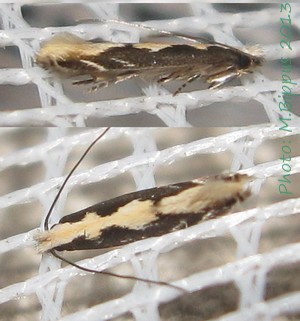
Amphixystis is a genus of moths belonging to the family Tineidae. The family was first described by Edward Meyrick in 1901.

Montescardia tessulatella is a moth of the family Tineidae. It is found in most of Europe, except the Iberian Peninsula, the Benelux, Britain, Ireland, the Balkan and Greece.
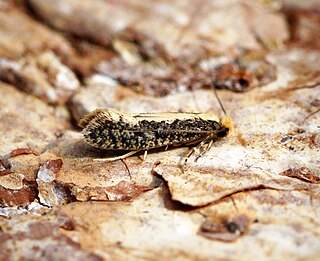
Monopis crocicapitella, the pale-backed clothes moth, is a moth of the family Tineidae described by James Brackenridge Clemens in 1859. It has a nearly cosmopolitan distribution. It was first described from the eastern United States. It is particularly destructive of fabric and clothes.
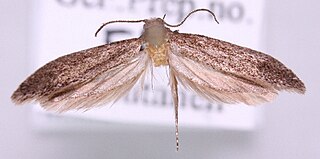
Elatobia fuliginosella is a moth of the family Tineidae. It was described by Friederike Lienig and Philipp Christoph Zeller in 1846. It is found in almost all of Europe, except Ireland, Great Britain, Portugal, the Benelux, Denmark and parts of the Balkan Peninsula, eastwards up to European Russia; in North Africa known from Morocco and Tunisia, eastwards through Siberia up to Mongolia.

Haplotinea ditella is a moth of the family Tineidae. It was described by Pierce & Metcalfe in 1938. It is found in most of Europe, except Ireland, France, Switzerland, the Iberian Peninsula and the western and southern part of the Balkan Peninsula.
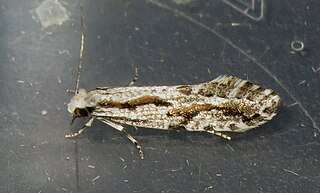
Archinemapogon yildizae is a moth of the family Tineidae. It was described by Ahmet Ömer Koçak in 1981. It is found in most of Europe, except Ireland, the Benelux, the Iberian Peninsula and most of the Balkan Peninsula. The habitat consists of birch woodlands.

Haplotinea insectella, the drab clothes moth or fungus grain moth, is a moth of the family Tineidae. It was described by Johan Christian Fabricius in 1794. It is found in all of Europe, except Ireland, the Iberian Peninsula and the western and southern part of the Balkan Peninsula. It is also found in North America. The species is often found in warehouses, granaries, mills and farm buildings.

Infurcitinea argentimaculella, the silver-barred clothes moth, is a moth of the family Tineidae. It was described by Stainton in 1849. It is found in most of Europe, except Ireland, Portugal, Latvia, Lithuania and the Balkan Peninsula.
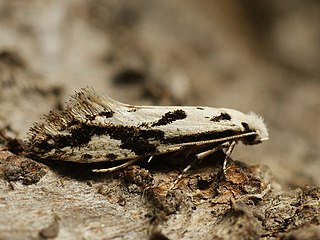
Nemapogon picarella, the pied clothes moth, is a moth of the family Tineidae. It was described by Carl Alexander Clerck in 1759. It is found in most of Europe, except Ireland, the Benelux, the Iberian Peninsula and the Balkan Peninsula.

Triaxomera fulvimitrella, the four-spotted clothes moth, is a moth of the family Tineidae. It is found in most of Europe, except Ireland, the Iberian Peninsula, Italy, Slovenia and most of the Balkan Peninsula. The habitat consists of woodlands.
Nemapogon signatella is a moth of the family Tineidae. It is found from Italy to the Balkan Peninsula and on Cyprus, as well as in Turkey, Jordan and Iran.

Tinea pallescentella, the large pale clothes moth, is a moth of the family Tineidae. It is found in most of Europe. It is also present in western North America, where it has been recorded from California. There are also records from South America and Australia.

Nemapogon clematella, the barred white clothes moth, is a moth of the family Tineidae. It is found in most of Europe and in North America, where it has been recorded from Maryland and North Carolina. The habitat consists of woodlands.

Nemapogon koenigi is a moth of the family Tineidae. It is found in most of Europe, except Ireland, Belgium, the Iberian Peninsula, Ukraine, Greece and probably most of the Balkan Peninsula.
Triaxomasia caprimulgella is a moth of the family Tineidae. It found in most of Europe, except Ireland, Luxembourg, Spain, Finland, the Baltic region, and the central part of the Balkan Peninsula.
Tinea dubiella is a species of moth belonging to the family Tineidae.

















